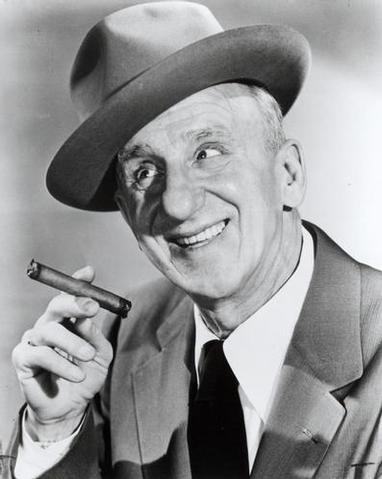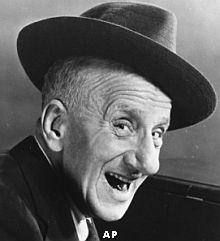Биография "Jimmy Durante"
<< Вернуться к списку всех песен "Jimmy Durante"
James Francis “Jimmy” Durante (February 10, 1893 – January 29, 1980) was an American singer, pianist, comedian and actor, whose distinctive gravel delivery, comic language butchery, jazz-influenced songs, and large nose – his frequent jokes about it included a frequent self-reference that became his nickname: «Schnozzola» – helped make him one of America’s most familiar and popular personalities of the 1920s through the 1970s.
Early career
Durante was born in Brooklyn, the third of four children born to Italian-Americans Mitch Durante (1855-1929) and Margaret (née Lentino) Durante (1858-1936). A product of working-class New York, Durante dropped out of school in the eighth grade to become a full-time ragtime pianist, working the city circuit and earning the nickname «Ragtime Jimmy,» before he joined one of the first recognizable jazz bands in New York, the Original New Orleans Jazz Band. Durante was the only member of the group who did not hail from New Orleans. His routine of breaking into a song to deliver a joke, with band or orchestra chord punctuation after each line became a Durante trademark. In 1920, the group was renamed Jimmy Durante’s Jazz Band.
Durante became a vaudeville star and radio attraction by the mid-1920s, with a music and comedy trio called Clayton, Jackson and Durante. Lou Clayton and Eddie Jackson, probably Durante’s closest friends, often reunited with Durante professionally. Jackson and Durante appeared in the Cole Porter musical The New Yorkers which opened on Broadway on December 8, 1930.
By 1934, he had a major record hit, his own novelty composition Inka Dinka Doo and it became his theme song for practically the rest of his life. A year later, Durante starred on Broadway in the Billy Rose stage musical Jumbo, in which a police officer stopped him while leading a live elephant and asked him, «What are you doing with that elephant?» Durante’s reply, «What elephant?», was a regular show-stopper. Durante also appeared on Broadway in Show Girl (1929), Strike Me Pink (1934), and Red, Hot and Blue (1936).
He began appearing in motion pictures at about the same time, beginning with a comedy series pairing him with silent film legend Buster Keaton and continuing with such offerings as The Wet Parade (1932), Broadway to Hollywood (1933), The Man Who Came to Dinner (1942, playing «Banjo», a character based on Harpo Marx), Ziegfeld Follies (1946), Billy Rose’s Jumbo (1962, based on the 1935 musical) and It’s a Mad, Mad, Mad, Mad World (1963).
Radio
On September 10, 1933 Durante appeared on Eddie Cantor’s popular The Chase and Sanborn Hour, continuing until November 12 of that year. When Cantor departed, Durante took over the NBC show as its star from April 22 to September 30, 1934, moving on to The Jumbo Fire Chief Program (1935-36).
He teamed with Garry Moore for The Durante-Moore Show in 1943. Durante’s comic chemistry with the young, brushcut Moore brought Durante an even larger audience. «Dat’s my boy dat said dat!» became an instant catchphrase. The duo became one of the nation’s favorites for the rest of the decade, including a well-reviewed Armed Forces Radio Network command performance with Frank Sinatra that remains a favorite of radio collectors today. Moore left in mid-1947, and the program returned October 1, 1947 as The Jimmy Durante Show. Durante worked in radio for three years after Moore’s 1947 departure, including a reunion of Clayton, Jackson and Durante on his April 21, 1948 broadcast.
Television
Durante made his television debut on November 1, 1950, though he kept a presence in radio as one of the frequent guests on Tallulah Bankhead’s two-year, NBC comedy-variety show, The Big Show. Durante was one of the cast on the show’s premiere November 5, 1950. The rest of the cast included humorist Fred Allen, singers Mindy Carson and Frankie Laine, stage musical performer Ethel Merman, actors Jose Ferrer and Paul Lukas, and comic-singer Danny Thomas (about to become a major television star in his own right). A highlight of the show was Durante and Thomas, whose own nose rivaled Durante’s, in a routine in which Durante accused Thomas of stealing his nose. «Stay outta dis, No-Nose!» Durante barked at Bankhead to a big laugh.
Beginning in the early 1950s, Durante teamed with sidekick Sonny King, a collaboration that would continue until Durante’s death. Jimmy could be seen regularly in Las Vegas after Sunday Mass outside of the Guardian Angel Cathedral standing next to the priest and greeting the people as they left Mass.
On August 4, 1955, The Jimmy Durante Show was the venue of the last performance by the famous Brazilian singer Carmen Miranda. Miranda fell to her knees while dancing with Durante, who instinctively told the band to «stop da music!». He helped Miranda up to her feet as she laughed «I’m all out of breath!». «Dat’s OK, honey, I’ll take yer lines» Durante replied. Miranda laughed again and quickly pulled herself together, finishing the show. However, the next morning, August 5, Carmen died at home from heart failure.
Marriages
Durante’s radio show was bracketed with two trademarks: «Inka Dinka Doo» as his opening theme, and the invariable signoff that became another familiar national catchphrase: «Good night, Mrs. Calabash, wherever you are.» Durante never revealed the meaning, preferring instead to keep the mystery alive.
One theory is that the phrase refers to the owner of a restaurant in Calabash, North Carolina, where Jimmy and his troupe stopped once to eat. He was so taken by the food, the service, and the chitchat that Jimmy told the owner that he would make her famous. Not knowing her name he instead referred to her as «Mrs. Calabash».[1]
Another theory is that it was his personal salute to his late first wife, Jeanne Olsen, whom he married on June 19, 1921. They stayed married until her death on Valentine’s Day in 1943. «Calabash» may have been a typical Durante mangle of Calabasas, the southern California locale where the couple made their home for the last years of her life.
If Valentine’s Day proved a day of sorrow for the comedian, he made Christmas Day, 1960, even more joyous than usual when he married his second wife, Marjorie Little, whom he had befriended for 16 years after meeting her at the Copacabana, where she worked as a hatcheck girl. She was 39, he 67, when they married. The couple adopted a baby, Cecelia Alicia (nicknamed CeCe), who became a horseback-riding instructor near San Diego, married a computer designer, and has two sons and a daughter.
Charitable work
Jimmy’s love for children continued through the Fraternal Order of Eagles, who among many causes raise money for handicapped and abused children. At Jimmy’s first appearance at the Eagles International Convention in 1961, judge Bob Hansen inquired about his fee for performing. Jimmy replied, «don’t even mention money judge or I’ll have to mention a figure that’ll make ya sorry ya brought it up.» «What can we do then?» asked Hansen. «Help da kids,» was Durante’s reply. Jimmy performed for many years at Eagles conventions free of charge, not even accepting travel money. The Fraternal Order of Eagles in his honor changed the name of their Children’s Fund to the Jimmy Durante Children’s Fund, and in his memory have raised over 20 million dollars to help children.
Later years
Durante in It’s a Mad, Mad, Mad, Mad World
Durante continued his film appearances through It’s a Mad, Mad, Mad, Mad World (1963) (in which his Smiler Grogan character tells a concerned crowd of $350,000 «buried under a big W» and then dies early in the film, literally «kicking the bucket») and television appearances through the early 1970s. He narrated the Rankin-Bass animated Christmas special Frosty the Snowman (1969), re-run for many years since. The television work also included a series of commercial spots for Kellogg’s Corn Flakes cereals in the mid 1960s, which introduced Durante’s gravelly growl and narrow-eyed, large-nosed countenance to millions of children. «Dis is Jimmy Durante, in puy-son!» was his introduction to some of the Kellogg’s spots. One of his last appearances was in a memorable television commercial for the 1973 Volkswagen Beetle, where he proclaimed that the new, roomier Beetle had «plenty of breathin’ room…for da old schnozzola!»
In 1963, Durante recorded an album of pop standards, September Song. The album became a best-seller and provided Durante’s re-introduction, to yet another generation, almost three decades later. His gravelly interpretation of «As Time Goes By» accompanied the opening credits of the romantic comedy hit, Sleepless in Seattle, while his version of «Make Someone Happy» launched the film’s closing credits. The former number appeared on the film’s best-selling soundtrack.
He wrote a foreword for a humorous book titled Cockeyed Americana, compiled by Dick Hyman. In the first paragraph of the «Foreword!,» as Durante called it, he met Hyman and discussed the book and the contribution Hyman wanted Durante to make to it. Durante wrote, «Before I can say gaziggadeegasackeegazobbath, we’re at his luxurious office.» After reading the material Hyman had compiled for the book, Durante commented on it, «COLOSSAL, GIGANTIC, MAGNANIMOUS, and last but not first, AURORA BOREALIS. [Captialization Durante’s.] Four little words that make a sentence—and a sentence that will eventually get me six months.»
Aside from «Dat’s my boy dat said dat!», «Dat’s moral turpentine!» and «It’s a catastastroke!» (for «catastrophe,») Durante sent such catch phrases as «Everybody wants ta get inta the act!», «Umbriago!» and «Ha-cha-cha-chaaaaaaa!» into the vernacular.
Durante suffered a stroke in 1972, and was confined to a wheelchair in the last years of his life. He died of pneumonia in Santa Monica, California on January 29, 1980, aged 86, and was interred at Holy Cross Cemetery, Culver City.
Early career
Durante was born in Brooklyn, the third of four children born to Italian-Americans Mitch Durante (1855-1929) and Margaret (née Lentino) Durante (1858-1936). A product of working-class New York, Durante dropped out of school in the eighth grade to become a full-time ragtime pianist, working the city circuit and earning the nickname «Ragtime Jimmy,» before he joined one of the first recognizable jazz bands in New York, the Original New Orleans Jazz Band. Durante was the only member of the group who did not hail from New Orleans. His routine of breaking into a song to deliver a joke, with band or orchestra chord punctuation after each line became a Durante trademark. In 1920, the group was renamed Jimmy Durante’s Jazz Band.
Durante became a vaudeville star and radio attraction by the mid-1920s, with a music and comedy trio called Clayton, Jackson and Durante. Lou Clayton and Eddie Jackson, probably Durante’s closest friends, often reunited with Durante professionally. Jackson and Durante appeared in the Cole Porter musical The New Yorkers which opened on Broadway on December 8, 1930.
By 1934, he had a major record hit, his own novelty composition Inka Dinka Doo and it became his theme song for practically the rest of his life. A year later, Durante starred on Broadway in the Billy Rose stage musical Jumbo, in which a police officer stopped him while leading a live elephant and asked him, «What are you doing with that elephant?» Durante’s reply, «What elephant?», was a regular show-stopper. Durante also appeared on Broadway in Show Girl (1929), Strike Me Pink (1934), and Red, Hot and Blue (1936).
He began appearing in motion pictures at about the same time, beginning with a comedy series pairing him with silent film legend Buster Keaton and continuing with such offerings as The Wet Parade (1932), Broadway to Hollywood (1933), The Man Who Came to Dinner (1942, playing «Banjo», a character based on Harpo Marx), Ziegfeld Follies (1946), Billy Rose’s Jumbo (1962, based on the 1935 musical) and It’s a Mad, Mad, Mad, Mad World (1963).
Radio
On September 10, 1933 Durante appeared on Eddie Cantor’s popular The Chase and Sanborn Hour, continuing until November 12 of that year. When Cantor departed, Durante took over the NBC show as its star from April 22 to September 30, 1934, moving on to The Jumbo Fire Chief Program (1935-36).
He teamed with Garry Moore for The Durante-Moore Show in 1943. Durante’s comic chemistry with the young, brushcut Moore brought Durante an even larger audience. «Dat’s my boy dat said dat!» became an instant catchphrase. The duo became one of the nation’s favorites for the rest of the decade, including a well-reviewed Armed Forces Radio Network command performance with Frank Sinatra that remains a favorite of radio collectors today. Moore left in mid-1947, and the program returned October 1, 1947 as The Jimmy Durante Show. Durante worked in radio for three years after Moore’s 1947 departure, including a reunion of Clayton, Jackson and Durante on his April 21, 1948 broadcast.
Television
Durante made his television debut on November 1, 1950, though he kept a presence in radio as one of the frequent guests on Tallulah Bankhead’s two-year, NBC comedy-variety show, The Big Show. Durante was one of the cast on the show’s premiere November 5, 1950. The rest of the cast included humorist Fred Allen, singers Mindy Carson and Frankie Laine, stage musical performer Ethel Merman, actors Jose Ferrer and Paul Lukas, and comic-singer Danny Thomas (about to become a major television star in his own right). A highlight of the show was Durante and Thomas, whose own nose rivaled Durante’s, in a routine in which Durante accused Thomas of stealing his nose. «Stay outta dis, No-Nose!» Durante barked at Bankhead to a big laugh.
Beginning in the early 1950s, Durante teamed with sidekick Sonny King, a collaboration that would continue until Durante’s death. Jimmy could be seen regularly in Las Vegas after Sunday Mass outside of the Guardian Angel Cathedral standing next to the priest and greeting the people as they left Mass.
On August 4, 1955, The Jimmy Durante Show was the venue of the last performance by the famous Brazilian singer Carmen Miranda. Miranda fell to her knees while dancing with Durante, who instinctively told the band to «stop da music!». He helped Miranda up to her feet as she laughed «I’m all out of breath!». «Dat’s OK, honey, I’ll take yer lines» Durante replied. Miranda laughed again and quickly pulled herself together, finishing the show. However, the next morning, August 5, Carmen died at home from heart failure.
Marriages
Durante’s radio show was bracketed with two trademarks: «Inka Dinka Doo» as his opening theme, and the invariable signoff that became another familiar national catchphrase: «Good night, Mrs. Calabash, wherever you are.» Durante never revealed the meaning, preferring instead to keep the mystery alive.
One theory is that the phrase refers to the owner of a restaurant in Calabash, North Carolina, where Jimmy and his troupe stopped once to eat. He was so taken by the food, the service, and the chitchat that Jimmy told the owner that he would make her famous. Not knowing her name he instead referred to her as «Mrs. Calabash».[1]
Another theory is that it was his personal salute to his late first wife, Jeanne Olsen, whom he married on June 19, 1921. They stayed married until her death on Valentine’s Day in 1943. «Calabash» may have been a typical Durante mangle of Calabasas, the southern California locale where the couple made their home for the last years of her life.
If Valentine’s Day proved a day of sorrow for the comedian, he made Christmas Day, 1960, even more joyous than usual when he married his second wife, Marjorie Little, whom he had befriended for 16 years after meeting her at the Copacabana, where she worked as a hatcheck girl. She was 39, he 67, when they married. The couple adopted a baby, Cecelia Alicia (nicknamed CeCe), who became a horseback-riding instructor near San Diego, married a computer designer, and has two sons and a daughter.
Charitable work
Jimmy’s love for children continued through the Fraternal Order of Eagles, who among many causes raise money for handicapped and abused children. At Jimmy’s first appearance at the Eagles International Convention in 1961, judge Bob Hansen inquired about his fee for performing. Jimmy replied, «don’t even mention money judge or I’ll have to mention a figure that’ll make ya sorry ya brought it up.» «What can we do then?» asked Hansen. «Help da kids,» was Durante’s reply. Jimmy performed for many years at Eagles conventions free of charge, not even accepting travel money. The Fraternal Order of Eagles in his honor changed the name of their Children’s Fund to the Jimmy Durante Children’s Fund, and in his memory have raised over 20 million dollars to help children.
Later years
Durante in It’s a Mad, Mad, Mad, Mad World
Durante continued his film appearances through It’s a Mad, Mad, Mad, Mad World (1963) (in which his Smiler Grogan character tells a concerned crowd of $350,000 «buried under a big W» and then dies early in the film, literally «kicking the bucket») and television appearances through the early 1970s. He narrated the Rankin-Bass animated Christmas special Frosty the Snowman (1969), re-run for many years since. The television work also included a series of commercial spots for Kellogg’s Corn Flakes cereals in the mid 1960s, which introduced Durante’s gravelly growl and narrow-eyed, large-nosed countenance to millions of children. «Dis is Jimmy Durante, in puy-son!» was his introduction to some of the Kellogg’s spots. One of his last appearances was in a memorable television commercial for the 1973 Volkswagen Beetle, where he proclaimed that the new, roomier Beetle had «plenty of breathin’ room…for da old schnozzola!»
In 1963, Durante recorded an album of pop standards, September Song. The album became a best-seller and provided Durante’s re-introduction, to yet another generation, almost three decades later. His gravelly interpretation of «As Time Goes By» accompanied the opening credits of the romantic comedy hit, Sleepless in Seattle, while his version of «Make Someone Happy» launched the film’s closing credits. The former number appeared on the film’s best-selling soundtrack.
He wrote a foreword for a humorous book titled Cockeyed Americana, compiled by Dick Hyman. In the first paragraph of the «Foreword!,» as Durante called it, he met Hyman and discussed the book and the contribution Hyman wanted Durante to make to it. Durante wrote, «Before I can say gaziggadeegasackeegazobbath, we’re at his luxurious office.» After reading the material Hyman had compiled for the book, Durante commented on it, «COLOSSAL, GIGANTIC, MAGNANIMOUS, and last but not first, AURORA BOREALIS. [Captialization Durante’s.] Four little words that make a sentence—and a sentence that will eventually get me six months.»
Aside from «Dat’s my boy dat said dat!», «Dat’s moral turpentine!» and «It’s a catastastroke!» (for «catastrophe,») Durante sent such catch phrases as «Everybody wants ta get inta the act!», «Umbriago!» and «Ha-cha-cha-chaaaaaaa!» into the vernacular.
Durante suffered a stroke in 1972, and was confined to a wheelchair in the last years of his life. He died of pneumonia in Santa Monica, California on January 29, 1980, aged 86, and was interred at Holy Cross Cemetery, Culver City.






